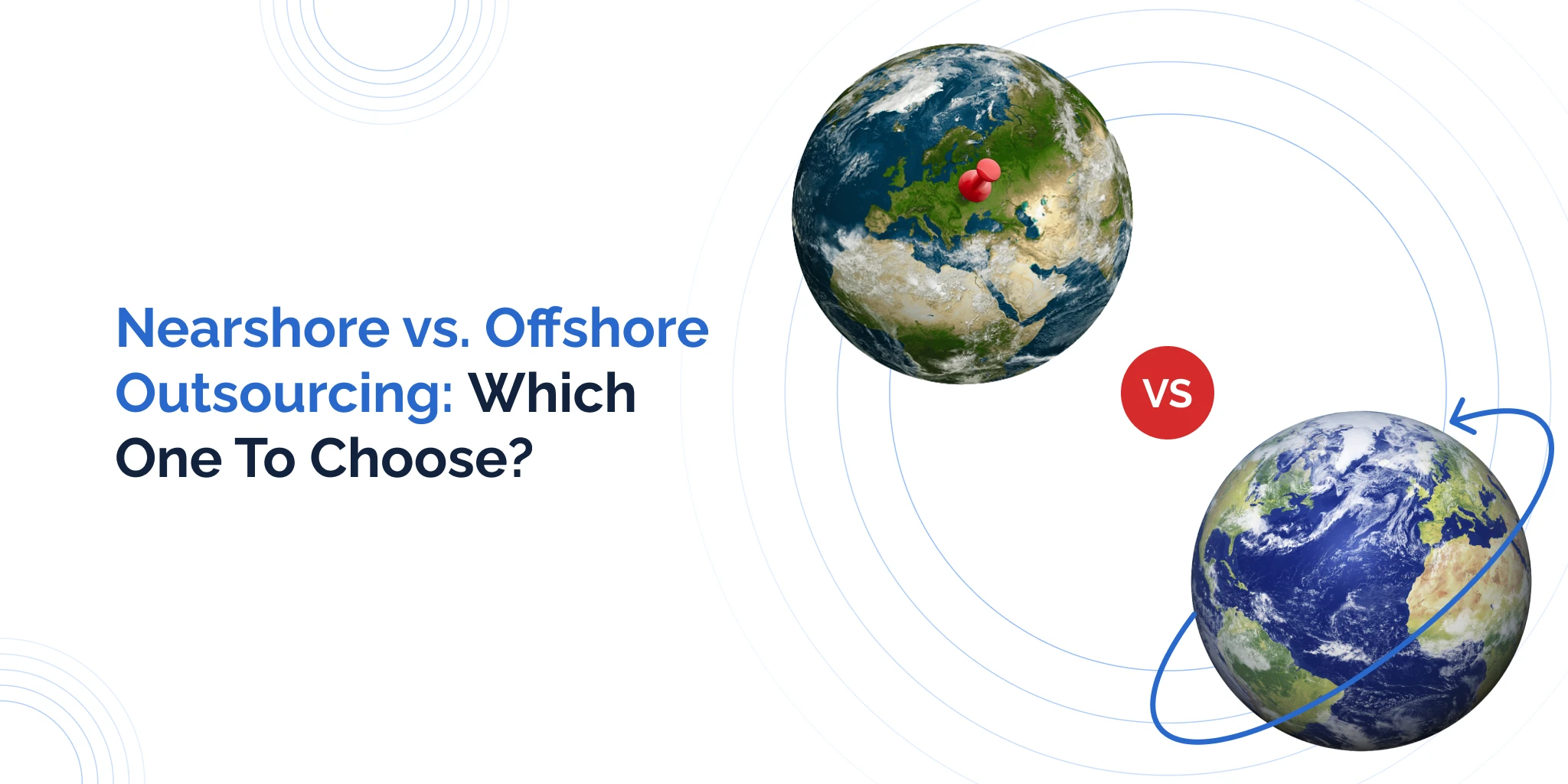Nearshore and offshore outsourcing are crucial for modern companies. Sometimes, finding the optimal team in your home country is difficult. Offshore and nearshore outsourcing solve this problem because they change the hiring location. Here, we look at the key characteristics of the presented solutions. They have advantages and disadvantages fitting different businesses. After reading this article, you’ll know which option is the best for your company.
Nearshore vs. Offshore: Overview
Both offshore and nearshore options involve outsourcing to other countries. What’s the difference, then? In the nearshore vs. offshore context, the former solution concerns closer countries and the latter the distant ones. Nearshore outsourcing is about hiring people near your country. For example, it occurs when an American IT firm hires some help from Canada. As for the offshore framework, it involves distant countries. A Mexican company hiring Polish, Indian, or Ukrainian developers engages in offshoring.
You also have to remember an additional element, onshore companies. What’s an onshore company? It’s an outsourcing business working in your country, requiring no cultural or legal space change. All frameworks have their positives and negatives, in our opinion. Let’s look at them!
What is Nearshore Outsourcing?
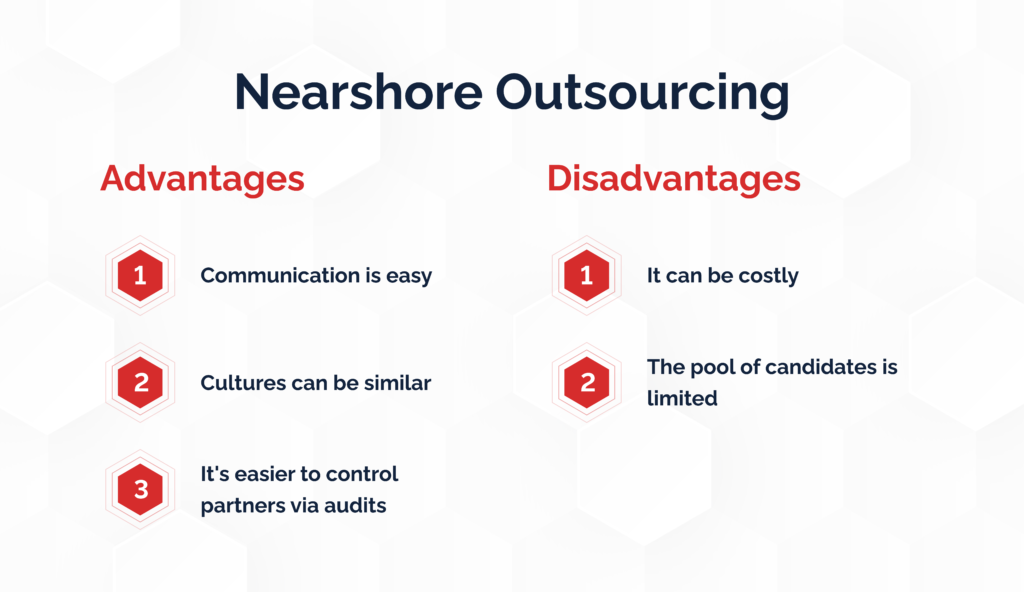
Nearshore outsourcing is from a country that’s near your state. Polish companies hiring developers in Ukraine use nearshoring. Nearshore vs. offshore outsourcing has its problems and benefits:
Advantages of Nearshore Outsourcing:
#1 Communication is easy
The first advantage of nearshore over offshore solutions is the similarity of time zones. You can comfortably contact colleagues as the office hours of both companies should be identical. This means the partners may synchronize tasks and do them without any waste of time. There won’t be any situations when a customer has to wait several hours or even an entire day for a response.
#2 Cultures can be similar
When hiring people from Mexico in the U.S., employers can expect a high level of compatibility. Yes, the Mexican culture has some unique characteristics, but it’s also in constant contact with the American one. The developers from the nearby countries are likely to know and adopt your demands for work ethics. In nearshore vs. offshore competition, the latter option is more difficult: Indians have their own understanding of the development processes. If you’re not ready for a period of establishing similar rules between companies, nearshoring is perfect because the speed of communication plays a key role.
#3 It’s easier to control partners via audits
The combination of better time zones and cultural compatibility simplifies audits. Firstly, one can reach the offshoring company’s office personally. It’s not difficult to imagine a business trip between the U.S. and Canada: planes or cars are viable choices. Secondly, cultural similarities mean standards are similar too. You don’t need to learn how people work in another country since a nearshore geographical zone has a unified coding culture, making control easy.
Disadvantages of Nearshore Outsourcing
#1 It can be costly
Nearshore vs. offshore solutions differs in prices. Mexican or Canadian coders work with the local space and charge as much or slightly lower than Americans. When the markets integrate, prices become similar. For the U.S. region, this means nearshoring makes no sense for saving funds. Its advantages are compatible cultures and time zones, but they don’t cut labor costs. Offshoring approaches are different, allowing you to hire people from regions with lower payments.
#2 The pool of candidates is limited
Another problem of nearshoring is relying on professionals from the local market. Every region has its own popular and unpopular technologies, leading to the lack of diversity in solutions. If your market uses Python a lot but avoids C++, investing in the second language in nearshoring will be expensive. The U.S. region has many well-established professionals who are conservative about their software choice. In the offshore markets, younger individuals are ready to start with something newer. In short, the nearshore vs. offshore competition is also about the nature of technologies. You choose between a limited pool of candidates who use popular frameworks or find something new.
What is Offshore Outsourcing?
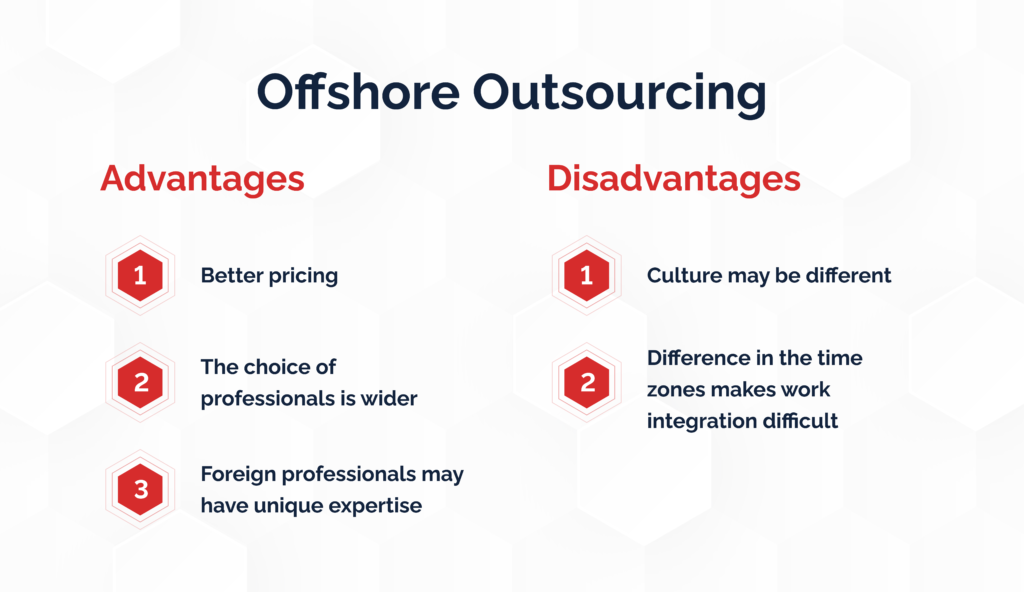
When doing offshore outsourcing, clients hire a company from a distant region. If a U.S. company hires a European one, it engages in offshoring. The usual characteristics of this framework are the time zone and cultural differences.
Advantages of Offshore Outsourcing:
#1 Better pricing
When companies choose nearshore vs. offshore production, price is the main factor. Nearshore solutions involve your region, with prices being stable for it. However, not every part of the world lives in the same way as the U.S. region. India, for example, has lower incomes than developed countries.
If one considers the concept of Purchase Parity, the prices for common services there are low too. It’s not as expensive to have a haircut in India as in the U.S. An average American requires 2000 dollars for comfortable life every month. An Indian lives in great conditions for 100 dollars. The income of 8000 dollars per year isn’t a starvation wage in India but a path to luxury. While a developer makes 100000 dollars annually in America, the prices are much lower in other countries. For instance, Ukrainians earn from 20000 to 36000 dollars per year. This means you can hire 5 to 10 specialists per expert in the U.S.
#2 The choice of professionals is wider
Finding a person who fits your company is difficult. When limited to the home market, you encounter some well-established traditions regarding programming. This works for projects made in the U.S. The problem is that luck isn’t always on your side. Some people may be against certain design features and refuse to implement them. Let’s imagine a business professional who wants to develop a cryptocurrency with a new development platform. Their home market can lack the professionals for this goal. One or two pioneers may demand too much for their services and have personality problems. While searching on foreign markets, companies work with a larger pool of professionals. Instead of 1-2 experts fitting some needs, one finds 10 or 20, making the search easier.
#3 Foreign professionals may have unique expertise
A common belief of people in developed countries is that their services are superior. Once Americans go to Eastern Europe, they quickly find out its integration with the Internet is much better. The explanation here is simple: they started integrating Western standards later and with better technology. The U.S. and Europe often have legacy systems for government services (for instance, mailing government documents). Nobody changes them as the reforms are expensive due to disrupting the traditional workflows. As the old saying goes, “if it works, don’t break it.”
The situation is different in post-Soviet or developing countries. Experts from Eastern Europe and India are developing e-passport projects, for instance. Moreover, they know how to deliver all vital government services through the Internet. If your state wants to develop something similar, the offshore vs. nearshore company choice is easy. The offshore specialists have more knowledge of all potential pitfalls and efficient choices.
Disadvantages of Offshore Outsourcing
#1 Culture may be different
No one is going to dispute that Indians and Americans have different cultures. This often means work standards in offshore vs. nearshore scenarios differ. Offshore specialists require time to adapt to your needs because their cultures have diverging demands. For example, Indian experts criticize things implicitly rather than explicitly. Failure is probable if you don’t know anything about these features. Nonetheless, we see this problem as temporary since globalization is doing its job: more and more people are adopting the American workstyle. China and Eastern Europe already work in the same mode as the U.S. They have strong result-oriented cultures and adhere to the strictest deadlines. India and Africa are next on the list, we’re sure.
#2 Difference in the time zones makes work integration difficult
A common issue in offshore vs. nearshore disputes is time zone differences. The proponents of nearshore solutions claim they’re superior due to similar timezones. The argument is easy: coders in nearshore work at the same time as your main office. An offshore company on another continent has several hours of worktime difference, making communication difficult. We agree this is an issue for some projects. For example, offshoring slows down processes if you hire developers to create models for a video game. It’s necessary to wait for changes longer: modifications often arrive at the end of your work day.
But, the problem is losing its strength because you can hire a developer who works night shifts and aligns with your labor time. Many companies also leave one or two developers for the night shift to act as ‘firefighters’ for some critical bugs and communication. The time difference is a problem, but there’s a way to solve it. The issues of nearshoring are more profound.
What is Onshore Outsourcing?
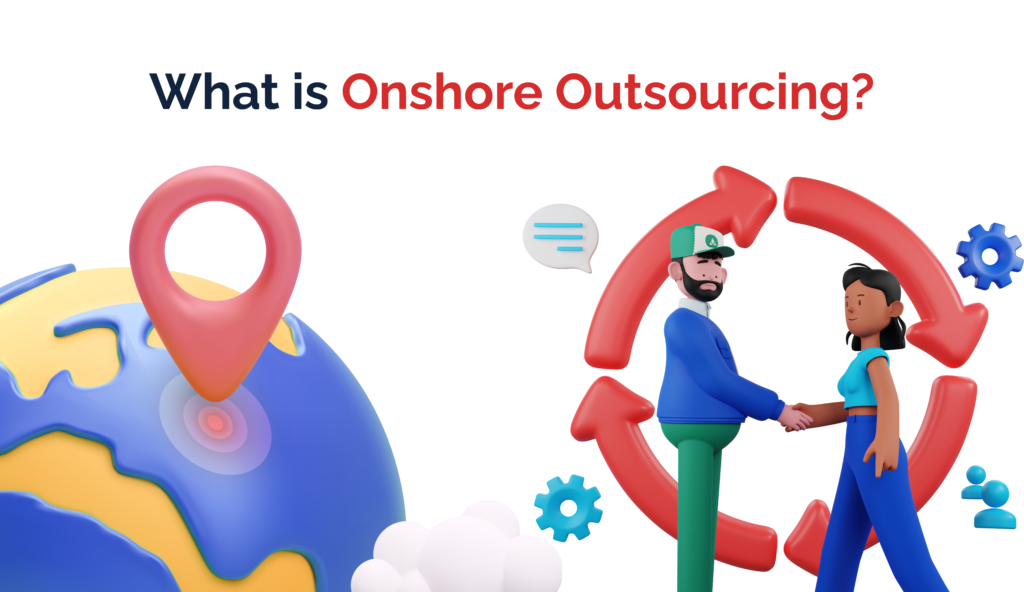
We’ve also mentioned onshore outsourcing in the opening paragraphs of this analysis. As presented above, you hire a company from your home country to perform some business tasks. For instance, when Ukrainian developers hire Ukrainian outsourcers, this is onshoring. The advantages and disadvantages are similar to the nearshore side in offshore vs. nearshore disputes. Onshoring solutions have the same time zones and cultures but fail on price and the talent pool (it’s even smaller than for nearshoring).
Nearshore vs. Offshore: Main Differences
Differences in a timezone
In the offshore vs. nearshore contest, nearshore solutions have better time zone integration. Nearshore companies are in your region, meaning they have the same time as you. This helps communication tremendously as work days cover similar periods. Offshore solutions aren’t as good: companies must rely on night shift workers or wait for feedback longer.
Price
Offshore vs. nearshore outsourcing has a clear winner for prices: offshoring companies are more cost-efficient. The reason is simple: they often stem from countries with lower incomes. For example, Indian developers work for 8000 to 10000 dollars per year, and Ukrainian ones have salaries between 24000 and 36000 dollars. You can hire more people with great expertise this way than in your native market.
Differences in culture
Another key issue of the offshore vs. nearshore outsourcing dilemma is culture. The prize for this one belongs to nearshore development. People from countries near yours are likely to have similar work demands. Even if their cultures differ (as Mexican and American), the common market erases the divergences. Working with people in nearshore markets is easier because you know what to expect.
Choice of specialists
Nearshore vs. offshore outsourcing is also different in the talent pool. Nearshore options limit clients to traditional solutions in the inner market. Moreover, the specialists’ pool is smaller (you work with a local rather than a global market). With offshore outsourcing, the problem isn’t as acute. Instead of working with C++ specialists from the Mexico-U.S.-Canada region, you find help from Eastern Europe, China, India, and Africa. This means the number of experts is bigger. Where an HR has 5 or 10 interesting nearshoring candidates, one finds 30 or 50. They can also have greater expertise in projects that aren’t common for your region. Creating a dream team is much easier with this offshoring rather than nearshoring.
Outsourcing Software Development: Clients and Vendors
The ‘conflict’ of nearshore vs. offshore outsourcing is becoming more meaningless for clients and vendors. Offshoring is now comfortable for clients because many companies are adopting alternative labor frameworks. Instead of relying on another company’s office time, you now get flexible options. It’s possible to have specialists in the office at night to assist clients, for instance. Some businesses even assemble entire teams centered around night shifts. Moreover, vendors have started to adopt the U.S. culture, as it’s the main market for IT solutions. Nearshoring positives become less pronounced: it still has the time zone advantage, but cultural issues are becoming smaller. If you’re interested in some interesting solutions, try our services.
Nearshore vs. Offshore: Best Choice for your Business
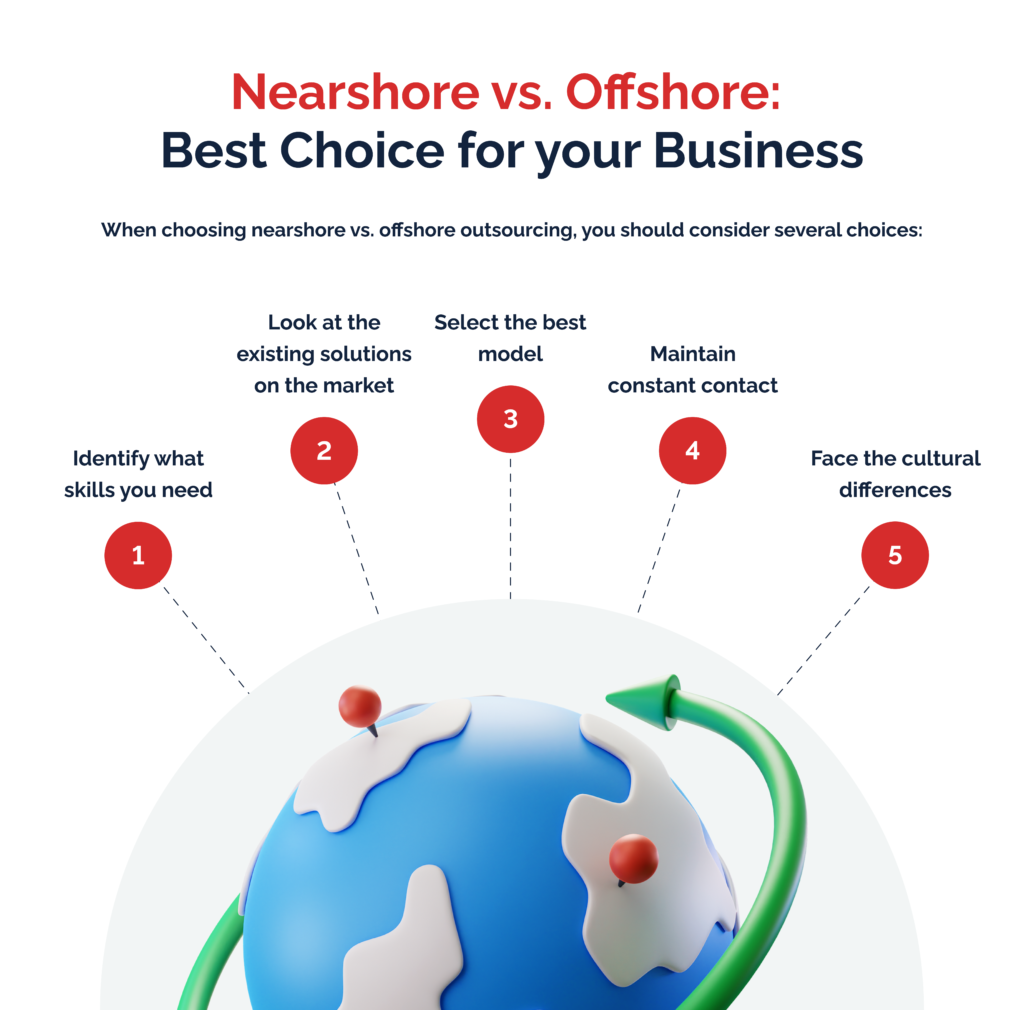
When choosing nearshore vs. offshore outsourcing, you should consider several choices:
#1 Identify what skills you need
Before hiring, it’s crucial to know what your perfect employee looks like. What skills should they possess? Do you want a developer from a country with very similar values, or you couldn’t care less? Create a full-scale profile for the potential worker and decide which markets satisfy you.
#2 Look at the existing solutions on the market
Many companies offer help with finding specialists. Some even give the choice of offshore vs. nearshore outsourcing. You should consider several firms and look at their diverging worker pools. In our opinion, this approach gives the greatest insights into foreign markets.
#3 Select the best model
Once you know your needs and see several solutions on the market, make your choice. Nearshore and offshore outsourcing work in different conditions. Nearshore is great when you require a similar culture and someone who reacts fast to your needs. Offshoring is better for lowering costs and finding some unique solutions.
#4 Maintain constant contact
If clients want a good project, the key choice is to focus on maintaining contact. How can you do this? Have a common chat with the workers and also prepare some specialists to answer their beginner questions. For offshoring, a great option is to have a project manager who can be the eyes and hands of the client. Our company offers a complex solution for this issue.
#5 Face the cultural differences
Regardless of the chosen model, there will be some cultural differences. The only divergence is their extent: when hiring an offshoring company, you can expect something major (language and culture barrier); for a nearshoring one, company standards/culture are a problem. It’s crucial to be tolerant and have an open mindset because when someone does work differently, it doesn’t mean they’re doing it badly.
Conclusion
To summarize, nearshore and offshore solutions fit different companies. With globalization, culture changes toward American standards, meaning that offshoring becomes increasingly attractive due to price. Nearshoring works when a cultural fit matters (for example, in video game development). The choices don’t concern quality: whatever you select, offshoring and nearshoring companies deliver great products.
Nearshore vs. Offshore Outsourcing FAQs
What is outsourcing?
Outsourcing is the process of giving certain tasks to another company. This business usually has its own teams and standards.
What is Nearshoring?
Nearshoring means hiring a company for outsourcing from the region near you (U.S. and Mexico, for instance).
What is Offshoring?
Offshoring means hiring a company for outsourcing from a distant region (U.S. and Ukraine, for example).
Our company helps with them: contact us, and we’ll present some solutions!

